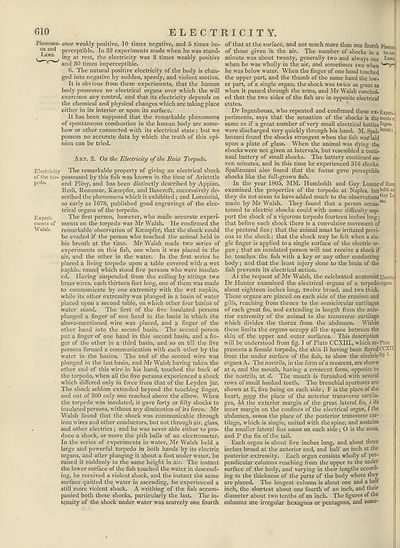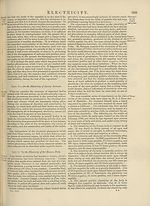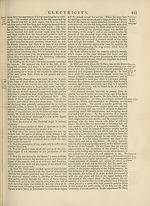Encyclopaedia Britannica > Volume 8, DIA-England
(620) Page 610
Download files
Complete book:
Individual page:
Thumbnail gallery: Grid view | List view

610
ELECTRICITY.
Phenome- once weakly positive, 10 times negative, and 5 times im-
na and perceptible. In 32 experiments made when he was stand-
■ y ing at rest, the electricity was 2 times weakly positive
~*- <^**s anj go times imperceptible.
6. The natural positive electricity of the body is chan¬
ged into negative by sudden, speedy, and violent motion.
It is obvious from these experiments, that the human
body possesses no electrical organs over which the will
exercises any control, and that its electricity depends on
the chemical and physical changes which are taking place
either in its interior or upon its surface.
It has been supposed that the remarkable phenomena
of spontaneous combustion in the human body are some¬
how or other connected with its electrical state; but we
possess no accurate data by which the truth of this opi¬
nion can be tried.
Art. 2. On the Electricity of the llaia Torpedo.
Electricity The remarkable property of giving an electrical shock
of the tor- possessed by this fish was known in the time of Aristotle
pedo. an(i Pliny, and has been distinctly described by Appian.
Redi, Reaumur, Kaempfer, and Bancroft, successively de¬
scribed the phenomena which it exhibited; and Lorenzini,
so early as 1678, published good engravings of the elec¬
trical organs of the torpedo.
Experi. The first person, however, who made accurate experi¬
ments of ments on the torpedo was Mr Walsh. He confirmed the
Walsh. remarkable observation of Kasmpfer, that the shock could
be evaded if the person who touched the animal held in
his breath at the time. Air Walsh made two series of
experiments on this fish, one when it was placed in the
air, and the other in the water. In the first series he
placed a living torpedo upon a table covered with a wet
napkin, round which stood five persons who were insulat¬
ed. Having suspended from the ceiling by strings two
brass wires, each thirteen feet long, one of them was made
to communicate by one extremity with the wet napkin,
while its other extremity was plunged in a basin of water
placed upon a second table, on which other four basins of
water stood. The first of the five insulated persons
plunged a finger of one hand in the basin in which the
above-mentioned wire was placed, and a finger of the
other hand into the second basin. The second person
put a finger of one hand in this second basin, and a fin¬
ger of the other in a third basin, and so on till the five
persons formed a communication with each other by the
water in the basins. The end of the second wire was
plunged in the last basin, and Mr Walsh having taken the
other end of this wire in his hand, touched the back of
the torpedo, when all the five persons experienced a shock
which differed only in force from that of the Leyden jar.
The shock seldom extended beyond the touching finger,
and out of 200 only one reached above the elbow. When
the torpedo was insulated, it gave forty or fifty shocks to
insulated persons, without any diminution of its force. Mr
Walsh found that the shock was communicable through
iron wires and other conductors, but not through air, glass,
and other electrics ; and he was never able either to pro¬
duce a shock, or move the pith balls of an electrometer.
In the series of experiments in water, Mr Walsh held a
large and powerful torpedo in both hands by its electric
organs, and after plunging it about a foot under water, he
raised it suddenly to the same height in air. The instant
the lower surface of the fish touched the water in descend¬
ing, he received a violent shock, and the instant the same
surface quitted the water in ascending, he experienced a
still more violent shock. A writhing of the fish accom¬
panied both these shocks, particularly the last. The in¬
tensity of the shock under water was scarcely one fourth
of that at the surface, and not much more than one fourth Phenor
of those given ih the air. The number of shocks in a na am
minute was about twenty, generally two and always one Laws
when he was wholly in the air, and sometimes two when '"''Y'
he was below water. When the finger of one hand touched
the upper part, and the thumb of the same hand the low¬
er part, of a single organ, the shock was twice as great as
when it passed through the arms, and Mr Walsh conclud¬
ed that the two sides of the fish are in opposite electrical
states.
Dr Ingenhousz, who repeated and confirmed these ex-Experi.
periments, says that the sensation of the shocks is the meats o
same as if a great number of very small electrical bottles Ingen-
were discharged very quickly through his hand. M. Spal-*10USZ;
lanzani found the shocks strongest when the fish was* laid
upon a plate of glass. When the animal was dying the
shocks were not given at intervals, but resembled a conti¬
nual battery of small shocks. The battery continued se¬
ven minutes, and in this time he experienced 316 shocks.
Spallanzani also found that the foetus gave perceptible
shocks like the full-grown fish.
In the year 1805, MM. Humboldt and Gay LussacofHum
examined the properties of the torpedo at Naples, butbol(,taii
they do not seem to have added much to the observationsGay
made by Mr Walsh. They found that a person accus-sac'
tomed to electric shocks could with some difficulty sup¬
port the shock of a vigorous torpedo fourteen inches long;
that before each shock there is a convulsive movement of
the pectoral fins; that the animal must be irritated previ¬
ous to the shock; that the shock may be felt when a sin¬
gle finger is applied to a single surface of the electric or¬
gan ; that an insulated person will not receive a shock if
he touches the fish with a key or any other conducting
body; and that the least injury done to the brain of the
fish prevents its electrical action.
At the request of Mr Walsh, the celebrated anatomist Electric
Dr Hunter examined the electrical organs of a torpedo organs,
about eighteen inches long, twelve broad, and two thick.
These organs are placed on each side of the cranium and
gills, reaching from thence to the semicircular cartilages
of each great fin, and extending in length from the ante¬
rior extremity of the animal to the transverse cartilage
which divides the thorax from the abdomen. Within
these limits the organs occupy all the space between the
skin of the upper and outer surfaces. This description
will be understood from fig. 1 of Plate CCXIIL, which re-Plate
presents a female torpedo, the skin B having been flayed CCXII
from the under surface of the fish, to show the electric %1-
organs A. The nostrils, in the form of a crescent, are shown
at c, and the mouth, having a crescent form, opposite to
the nostrils, at d. The mouth is furnished with several
rows of small hooked teeth. The bronchial apertures are
shown at E, five being on each side; F is the place of the
heart, gggg the place of the anterior transverse cartila¬
ges, hh the exterior margin of the great lateral fin, i its
inner margin on the confines of the electrical organ, l the
abdomen, mmm the place of the posterior transverse car¬
tilage, which is single, united with the spine, and sustains
the smaller lateral fins nnnn on each side; O is the anus,
and P the fin of the tail.
Each organ is about five inches long, and about three
inches broad at the anterior end, and half an inch at the
posterior extremity. Each organ consists wholly of per¬
pendicular columns reaching from the upper to the under
surface of the body, and varying in their lengths accord¬
ing to the thickness of the parts of the body where they
are placed. The longest column is about one and a half
inch, the shortest about one fourth of an inch, and their
diameter about two tenths of an inch. The figures of the
columns are irregular hexagons or pentagons, and some-
ELECTRICITY.
Phenome- once weakly positive, 10 times negative, and 5 times im-
na and perceptible. In 32 experiments made when he was stand-
■ y ing at rest, the electricity was 2 times weakly positive
~*- <^**s anj go times imperceptible.
6. The natural positive electricity of the body is chan¬
ged into negative by sudden, speedy, and violent motion.
It is obvious from these experiments, that the human
body possesses no electrical organs over which the will
exercises any control, and that its electricity depends on
the chemical and physical changes which are taking place
either in its interior or upon its surface.
It has been supposed that the remarkable phenomena
of spontaneous combustion in the human body are some¬
how or other connected with its electrical state; but we
possess no accurate data by which the truth of this opi¬
nion can be tried.
Art. 2. On the Electricity of the llaia Torpedo.
Electricity The remarkable property of giving an electrical shock
of the tor- possessed by this fish was known in the time of Aristotle
pedo. an(i Pliny, and has been distinctly described by Appian.
Redi, Reaumur, Kaempfer, and Bancroft, successively de¬
scribed the phenomena which it exhibited; and Lorenzini,
so early as 1678, published good engravings of the elec¬
trical organs of the torpedo.
Experi. The first person, however, who made accurate experi¬
ments of ments on the torpedo was Mr Walsh. He confirmed the
Walsh. remarkable observation of Kasmpfer, that the shock could
be evaded if the person who touched the animal held in
his breath at the time. Air Walsh made two series of
experiments on this fish, one when it was placed in the
air, and the other in the water. In the first series he
placed a living torpedo upon a table covered with a wet
napkin, round which stood five persons who were insulat¬
ed. Having suspended from the ceiling by strings two
brass wires, each thirteen feet long, one of them was made
to communicate by one extremity with the wet napkin,
while its other extremity was plunged in a basin of water
placed upon a second table, on which other four basins of
water stood. The first of the five insulated persons
plunged a finger of one hand in the basin in which the
above-mentioned wire was placed, and a finger of the
other hand into the second basin. The second person
put a finger of one hand in this second basin, and a fin¬
ger of the other in a third basin, and so on till the five
persons formed a communication with each other by the
water in the basins. The end of the second wire was
plunged in the last basin, and Mr Walsh having taken the
other end of this wire in his hand, touched the back of
the torpedo, when all the five persons experienced a shock
which differed only in force from that of the Leyden jar.
The shock seldom extended beyond the touching finger,
and out of 200 only one reached above the elbow. When
the torpedo was insulated, it gave forty or fifty shocks to
insulated persons, without any diminution of its force. Mr
Walsh found that the shock was communicable through
iron wires and other conductors, but not through air, glass,
and other electrics ; and he was never able either to pro¬
duce a shock, or move the pith balls of an electrometer.
In the series of experiments in water, Mr Walsh held a
large and powerful torpedo in both hands by its electric
organs, and after plunging it about a foot under water, he
raised it suddenly to the same height in air. The instant
the lower surface of the fish touched the water in descend¬
ing, he received a violent shock, and the instant the same
surface quitted the water in ascending, he experienced a
still more violent shock. A writhing of the fish accom¬
panied both these shocks, particularly the last. The in¬
tensity of the shock under water was scarcely one fourth
of that at the surface, and not much more than one fourth Phenor
of those given ih the air. The number of shocks in a na am
minute was about twenty, generally two and always one Laws
when he was wholly in the air, and sometimes two when '"''Y'
he was below water. When the finger of one hand touched
the upper part, and the thumb of the same hand the low¬
er part, of a single organ, the shock was twice as great as
when it passed through the arms, and Mr Walsh conclud¬
ed that the two sides of the fish are in opposite electrical
states.
Dr Ingenhousz, who repeated and confirmed these ex-Experi.
periments, says that the sensation of the shocks is the meats o
same as if a great number of very small electrical bottles Ingen-
were discharged very quickly through his hand. M. Spal-*10USZ;
lanzani found the shocks strongest when the fish was* laid
upon a plate of glass. When the animal was dying the
shocks were not given at intervals, but resembled a conti¬
nual battery of small shocks. The battery continued se¬
ven minutes, and in this time he experienced 316 shocks.
Spallanzani also found that the foetus gave perceptible
shocks like the full-grown fish.
In the year 1805, MM. Humboldt and Gay LussacofHum
examined the properties of the torpedo at Naples, butbol(,taii
they do not seem to have added much to the observationsGay
made by Mr Walsh. They found that a person accus-sac'
tomed to electric shocks could with some difficulty sup¬
port the shock of a vigorous torpedo fourteen inches long;
that before each shock there is a convulsive movement of
the pectoral fins; that the animal must be irritated previ¬
ous to the shock; that the shock may be felt when a sin¬
gle finger is applied to a single surface of the electric or¬
gan ; that an insulated person will not receive a shock if
he touches the fish with a key or any other conducting
body; and that the least injury done to the brain of the
fish prevents its electrical action.
At the request of Mr Walsh, the celebrated anatomist Electric
Dr Hunter examined the electrical organs of a torpedo organs,
about eighteen inches long, twelve broad, and two thick.
These organs are placed on each side of the cranium and
gills, reaching from thence to the semicircular cartilages
of each great fin, and extending in length from the ante¬
rior extremity of the animal to the transverse cartilage
which divides the thorax from the abdomen. Within
these limits the organs occupy all the space between the
skin of the upper and outer surfaces. This description
will be understood from fig. 1 of Plate CCXIIL, which re-Plate
presents a female torpedo, the skin B having been flayed CCXII
from the under surface of the fish, to show the electric %1-
organs A. The nostrils, in the form of a crescent, are shown
at c, and the mouth, having a crescent form, opposite to
the nostrils, at d. The mouth is furnished with several
rows of small hooked teeth. The bronchial apertures are
shown at E, five being on each side; F is the place of the
heart, gggg the place of the anterior transverse cartila¬
ges, hh the exterior margin of the great lateral fin, i its
inner margin on the confines of the electrical organ, l the
abdomen, mmm the place of the posterior transverse car¬
tilage, which is single, united with the spine, and sustains
the smaller lateral fins nnnn on each side; O is the anus,
and P the fin of the tail.
Each organ is about five inches long, and about three
inches broad at the anterior end, and half an inch at the
posterior extremity. Each organ consists wholly of per¬
pendicular columns reaching from the upper to the under
surface of the body, and varying in their lengths accord¬
ing to the thickness of the parts of the body where they
are placed. The longest column is about one and a half
inch, the shortest about one fourth of an inch, and their
diameter about two tenths of an inch. The figures of the
columns are irregular hexagons or pentagons, and some-
Set display mode to:
![]() Universal Viewer |
Universal Viewer | ![]() Mirador |
Large image | Transcription
Mirador |
Large image | Transcription
Images and transcriptions on this page, including medium image downloads, may be used under the Creative Commons Attribution 4.0 International Licence unless otherwise stated. ![]()
| Encyclopaedia Britannica > Encyclopaedia Britannica > Volume 8, DIA-England > (620) Page 610 |
|---|
| Permanent URL | https://digital.nls.uk/193331065 |
|---|
| Attribution and copyright: |
|
|---|
| Description | Ten editions of 'Encyclopaedia Britannica', issued from 1768-1903, in 231 volumes. Originally issued in 100 weekly parts (3 volumes) between 1768 and 1771 by publishers: Colin Macfarquhar and Andrew Bell (Edinburgh); editor: William Smellie: engraver: Andrew Bell. Expanded editions in the 19th century featured more volumes and contributions from leading experts in their fields. Managed and published in Edinburgh up to the 9th edition (25 volumes, from 1875-1889); the 10th edition (1902-1903) re-issued the 9th edition, with 11 supplementary volumes. |
|---|---|
| Additional NLS resources: |
|

